Lexus LS
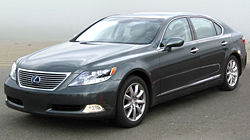 |
|
| Manufacturer | Lexus |
|---|---|
| Parent company | Toyota Motor Corporation |
| Production | 1989–present |
| Assembly | Tahara, Aichi, Japan |
| Class | Full-size luxury car |
| Body style(s) | 4-door sedan |
| Layout | FR / RWD // F4 / AWD |
The Lexus LS is a full-size luxury sedan that serves as the flagship of Lexus, the luxury division of Toyota. Since Lexus' debut, four generations of the V8-powered, rear-wheel drive Lexus LS have been produced. The original LS 400, the first vehicle of the Lexus marque, premiered in 1989. Subsequent generations of the Lexus flagship added technological features, luxury appointments, and safety innovations. The Lexus LS is recognized as one of the most reliable vehicles ever built,[1] and its cabin is regarded among the quietest of luxury automobiles.[2] Each successive Lexus LS design has become the best-selling prestige luxury sedan in the United States.[3][4]
In 2006, Lexus launched the fourth generation LS Series, offering the first long wheelbase version of the Lexus flagship. Beginning with the 2008 model year, an all-wheel drive hybrid joined the line up. This generation of LS also introduces the latest in Lexus technology, including the first production eight-speed automatic transmission,[5] an automatic parking system, and on the hybrid models, the first production LED headlamps in the U.S. market.[6] Several different Lexus LS models are sold worldwide, including standard, long wheelbase, hybrid, and all-wheel-drive versions. In its largest market, the United States, starting prices for the 2008 Lexus LS range from $61,500 for the standard wheelbase LS 460 to over $104,000 for the long wheelbase hybrid LS 600h L.[7]
Lexus' flagship model has held the highest ranking in J.D. Power’s Vehicle Dependability Survey for over twelve consecutive years,[8] and Consumer Reports has named the LS as the most dependable vehicle ever tested.[9] In 2007, international jurors named the LS 460 as the World Car of the Year.[5]
Contents |
Lexus LS historical overview
In August 1983, Toyota chairman Eiji Toyoda initiated the F1 project ("Flagship" and "No. 1 vehicle"; alternatively called the "Circle-F" project), a top secret effort aimed at producing a world-class luxury sedan. Unlike past Toyota efforts, the F1 project was not bound by a specific budget or time constraints. It also did not utilize existing Toyota vehicle platforms or parts.[10][11] Instead, chief engineer Ichiro Suzuki sought to develop an all-new design that would surpass existing flagship luxury sedans. Specific targets included: a more aerodynamic exterior, quieter cabin, higher top speed, and more fuel-efficient design versus American and European rivals.[12] However, there is some speculation that a modified Mark II/Chaser/Cresta/Cressida platform was used during the development of the F1, and the UCF10 LS.
To achieve their goals, F1 engineers produced new concepts and part designs, resulting in hundreds of patent applications.[13] Their final design would have among the lowest drag coefficients of any production vehicle (Cd 0.29), record a quiet 58 dB of cabin noise at a cruising speed of 62 mph (100 km/h), and exhibit lower levels of vibration than rival sedans.[14] The F1 design's new 4.0 L V8 engine produced 250 hp (190 kW), had a maximum speed of 155 mph (250 km/h), and avoided the U.S. gas-guzzler tax.

Over a period of five years, a team of over 3,900 engineers, technicians, and other F1 personnel built some 450 flagship prototypes and 900 engine prototypes.[15] The prototype F1 vehicles were driven over a total of 2.7 million kilometers on testing locations ranging from winter Europe roadways, deserts in Arizona, Australia, and Saudi Arabia, to U.S. highways and wilderness areas.[16][17] To ensure quality, more precise manufacturing standards were developed to produce higher levels of fit and finish in the new sedan.[18][19] Toyota's Tahara plant, a highly automated facility, was selected as the site of production. Materials selection tests examined multiple types of leather and scrutinized 24 different kinds of wood for use in the passenger cabin.[20] Total costs for the project exceeded $1 billion.[21]
By 1986, Toyota executives had decided to form a new luxury division, Lexus, to support the launch of their flagship sedan. The final design of the resulting Lexus LS 400 (UCF10) was approved in 1987 and premiered at U.S. and international auto shows in 1989. Although the LS 400 was initially developed as a standalone flagship for Lexus, it was ultimately sold alongside the ES 250, an entry-level luxury car based on the Toyota Camry.[22] The first Lexus dealerships in the U.S. began sales of the Lexus LS and its stablemate in September 1989. Sales in Australia, Canada, and Europe began in 1990. In Japan, an equivalent, right-hand drive model was sold as the Toyota Celsior until Lexus' domestic debut in 2006. The Toyota Celsior had more upgrades that were added later on the LS, such as rear air conditioning and massage seats. Toyota worked with Sega to produced a set of advertising tie-in discs using Dreamcast consoles, which featured detailed 3d models and video of the Celsior.[23]

In its first four months on sale, Lexus sold 11,574 LS 400 models in the U.S.[24] First-year sales exceeded Lexus' forecasts and totaled 63,534 for 1990.[25][26] By 1991, on the strength of the LS' sales success, Lexus became the top-selling luxury import in the United States. The LS regularly outsold its rivals, becoming the top-selling luxury flagship vehicle in the U.S.—a title it achieved 15 out of the first 17 years since its debut.[3] In 1995, Lexus unveiled the redesigned, second generation LS 400 (UCF20), featuring a longer wheelbase with similar styling and specifications as the original model. The third generation LS 430 (UCF30) premiered in 2001, introducing a new body design and a host of new interior and technological features. In 2006, Lexus debuted in the Japanese market, signaling the end of Toyota Celsior sales, and continued to offer the Japanese the Toyota Crown Majesta with similar dimensions to the Celsior that was introduced in 1991. From that point forward, the LS was exclusively sold under the Lexus nameplate in every available market.
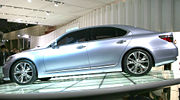
The fourth generation LS (USF40 / USF41) premiered as a hybrid concept car, the LF-Sh, in Fall 2005, and the LS Series was formally revealed at the North American International Auto Show in January 2006. For the first time, the Lexus LS was offered in both standard and long wheelbase versions. Innovations on the new LS 460 and LS 460 L included advanced safety features, real-time traffic updates, onboard infrared sensors, and more luxury features than on previous models. The Lexus LS series of luxury flagship sedans went on sale worldwide in late 2006, furthering Lexus' efforts to establish itself as a global luxury brand. The hybrid models, the LS 600h and LS 600h L (UVF45 / UVF46), became available in the U.S., Japan, and Europe in mid-2007. All LS sedans continue to be exclusively produced at the Tahara, Japan plant, which has since received multiple automotive manufacturing plant awards for quality.[27]
First generation (UCF10)
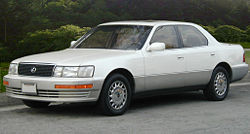 |
|
| Also called | Toyota Celsior (JDM) |
|---|---|
| Production | 1989–1994 |
| Layout | FR layout |
| Engine(s) | 4.0 L 256 hp (191 kW) 1UZ-FE V8 |
| Transmission(s) | 4-speed automatic |
| Wheelbase | 110.8 in (2814 mm) |
| Length | 196.7 in (4996 mm) |
| Width | 1990-92: 71.7 in (1821 mm) 1993-94: 72.0 in (1829 mm) |
| Height | 1990-92: 55.3 in (1405 mm) 1993-94: 55.7 in (1415 mm) |
| Curb weight | 3759 lb (1708 kg) (UCF10 I) 3858 lb (1750 kg) (UCF10 II) |
| Fuel capacity | 22.5 US gal (85 L/19 imp gal) |
UCF10 I (1989)
In January 1989, the first flagship of the Lexus line, the LS 400 (UCF10 I), made its debut at the North American International Auto Show. Designed to compete head-to-head with the luxury flagships of the leading auto manufacturers, the first generation LS was among the first luxury sedans to feature power adjustable shoulder belts and electrochromic rear-view mirror.[28] The five-passenger cabin also featured a walnut and leather-trimmed interior, power-adjustable memory seats, soft-touch controls, electroluminescent Optitron gauges, and the first automatic tilt-and-telescoping steering wheel with SRS airbag.[29] The vehicle featured an independent, double-wishbone suspension setup.[30] Available options were an air suspension (used to raise or lower the vehicle), a Nakamichi premium sound system, and an integrated cellular telephone with hands-free capabilities. Sandwich steel body panels were introduced to further reduce cabin noise.[31] Equipped with a 4.0 L V8 engine and rear wheel drive, the LS 400 could accelerate from 0-60 in 7.9 seconds and featured a top speed of 250 km/h (155 mph).
The LS 400 introduced the Lexus nameplate to the U.S. and worldwide markets, and won critical acclaim from the press. Wheels magazine named the LS 400 its Car of the Year and Car and Driver magazine named it to its Ten Best list for 1990. In 1989 comparison tests, Automobile Magazine and Car and Driver both rated the LS 400 as the best flagship luxury sedan over competing models ranging from Audi, BMW, Cadillac, Infiniti, Jaguar, and Mercedes-Benz.[32] The LS400 debuted at $38,000, and it was rated as better than both the $63,000 Mercedes 420SEL and the $55,000 BMW 735i in terms of ride, handling and performance. [33] (In some markets, it was priced against mid-sized six cylinder Mercedes-Benz and BMW models).[34] Reviewers found the LS 400 superior in comfort, engine performance, ergonomics, ride quality, styling, and overall value,[35] while critics faulted styling and the softer, more isolated ride (depending on suspension setup).[36] The largely positive reaction (with similar results in other reviews) stunned the automotive industry, as a relative newcomer had beaten long-established brands at their own game.[29][37]
Shortly after its launch as the marque's inaugural and flagship vehicle, Lexus ordered a recall of the 8000 vehicles sold so far, based upon just two customer complaints. A dealership recalled that the "company didn't run and hide", instead launching a sweeping operation. Instead of asking owners to visit dealers, Lexus sent technicians to quickly pickup, repair, and return the LS cars to the customer, even flying in personnel and renting garage space for owners in remote locations. The general manager of Lexus USA said "We saw it as an opportunity to cement our relationship with the customer right from the beginning".[38]
The first generation LS was a commercial success, selling between 21,000 and 42,000 units annually.[24] The base price for the U.S. market first generation LS in 1989–1990 was $35,000 with an additional $350 destination charge in California. This initial price undercut competitors by thousands of dollars and provided the already well-reviewed LS 400 with an added value incentive for prospective buyers. Total sales of the LS 400 exceeded 166,000 units. The success of the LS 400 cost rivals billions in revenue and was credited with shifting the dynamics of the luxury market.[39] In order to compete with Lexus, competitors were forced to adjust pricing and add more standard equipment and advanced features.[40] An estimated five percent of 1989 early sales went to rival manufacturers, who secretly disassembled the vehicle for analysis.[41] In 1996, Automobile Magazine named the first generation LS as one of the "24 Most Important Vehicles of the 20th Century," in recognition of the impact the vehicle had on the automotive industry.[42]
UCF10 II (1993)

For the 1993 model year, the refreshed LS 400 (UCF10 II) was introduced with more than 50 changes, largely in response to customer and dealer requests.[43] Some of these changes included larger brake rotors, wheels and tires, CFC-free refrigerant, additional body side moldings, and a revised grille along with a greater selection of colors. Adjustments were made to the vehicle's suspension and power steering system to improve handling. For the interior, passenger front airbags, an external temperature gauge, digital odometer, and seatbelt pretensioners were added. These changes added to a number of convenience and performance improvements which the LS 400 had received in preceding years. By 1994, the LS 400's U.S. base price exceeded $50,000,[34] a figure that had steadily risen since the vehicle's introduction. Customer demand for the vehicle and shifts in foreign exchange rates contributed to the increase in price.[44]
Second generation (UCF20)
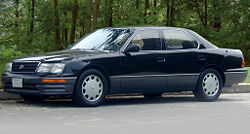 |
|
| Also called | Toyota Celsior (JDM) |
|---|---|
| Production | 1995–2000 |
| Layout | FR layout |
| Engine(s) | 1UZ-FE 4.0 L V8 261 hp (195 kW) 1995–1997 |
| Transmission(s) | 4-speed automatic 5-speed automatic (UCF20 II) |
| Wheelbase | 112.2 in (2850 mm) |
| Length | 196.7 in (4996 mm) |
| Width | 72.0 in (1829 mm) |
| Height | 1995-97: 55.9 in (1420 mm) 1998–2000: 56.5 in (1435 mm) |
| Curb weight | 3650 lb (1659 kg) (UCF20) 3890 lb (1764 kg) (UCF20 II) |
| Fuel capacity | 22.5 US gal (85 L/19 imp gal) (UCF20) 21.9 US gal (83 L/18 imp gal) (UCF20 II) |
UCF20 I (1995)
A redesigned second generation LS 400 (UCF20) was introduced in 1995.[45] While the UCF20 retained the general profile and contours of the original LS, over ninety percent of its internal composition was new or redesigned. The wheelbase increased by 1.4 in. (35.6 mm), resulting in more interior space and an additional 2.6 in. of rear seat legroom (66.0 mm). However, trunk capacity was slightly reduced. The updated 4.0 L V8 engine gave the second generation LS more power and torque,[45] and the body design (developed by the Calty Design Research center in the U.S.) was more aerodynamic (Cd 0.28) than the preceding model.[34][46] The UCF20 featured increased sound insulation, a strengthened body structure, suspension updates, and improved brakes. Even with these upgrades, the redesigned model was 209 lb (95 kg) lighter than the original, and achieved slightly better fuel economy.[45]
The interior also received a facelift and new features. Automatic dual-zone climate controls added convenience while the updated dashboard, center console and storage compartments, including rear cupholders, increased functionality.[43] To further enhance driving comfort, a patented seat cushion design, similar to the car's suspension, featured lightweight internal coil springs and stabilizer bars.[45] One of the first in-dash CD changers was offered as an option.[45] Safety enhancements included enlarged crumple zones, three-point seatbelts at all positions, and a new collapsible steering column.[45]
Reviewers concluded that the second generation model stayed relatively close to the attributes of the original. Later interviews further revealed that although more radical proposals were considered, Lexus engineers opted for a traditional approach, ensuring that very few dramatic changes were incorporated for this first LS redesign.[46] The new model's roomier cabin, improved ergonomics, and smooth but isolated ride received praise.[34][46] However, some reviewers wrote that redesigned European competitors surpassed the LS in terms of road handling and breadth of available features and options.[34]
Ultimately, the UCF20 model sales were not as voluminous as the original model, reaching just over 110,000 units during its six-year production run.[46][24] But, it was still the best-selling full size luxury sedan in the United States. The redesigned LS 400 also retained a significant pricing advantage against its more expensive competition, launching with a U.S. base price of $51,680 in 1995, and reaching the mid-$50,000 range in later years.
UCF20 II (1998)

For the 1998 model year, the revised LS 400 (UCF20 II) was introduced featuring a new 290 hp (216 kW) VVT-i 1UZ-FE engine mated with a five-speed automatic transmission. The new engine improved 0-60 mph acceleration to 6.4 seconds while adding 30 ft·lbf (41 N·m) of torque. The UCF20 II sported a new front fascia (with an increased gap between the headlights and grille), revised headlights (with a HID option), slightly refined tail lights, five spoke alloy wheels, and reshaped side mirrors for reduced wind noise.[43] Fuel economy was further increased to 19 miles per US gallon (8.1 km/l/23 mpg-imp) city, 25 miles per US gallon (11 km/l/30 mpg-imp) highway (then-current EPA standards).
New standard safety features included front side air bags, traction control (TRAC), Vehicle Stability Control,[43] and a window jam protection system. New interior amenities included retractable rear headrests, additional wood accents on the steering wheel and gear selector, and a GPS-linked, hard-disk drive based navigation system with a concealed antenna. The HomeLink wireless control system and trip computer modernized the cabin, and adaptive cruise control was an option. For added convenience and security, the headlights were equipped with a programmable delay feature which allowed them to remain illuminated as the occupants exited the vehicle (or if a door was left ajar).[43] Window and sunroof controls were also added to the remote control.
Third generation (UCF30)
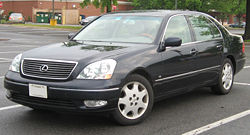 |
|
| Also called | Toyota Celsior (JDM) ended Sept 2006 |
|---|---|
| Production | 2001–2006 |
| Layout | FR layout |
| Engine(s) | 3UZ-FE 4.3 L V8 290 hp (220 kW) |
| Transmission(s) | 5-speed automatic; 6-speed automatic |
| Wheelbase | 115.2 in (2926 mm) |
| Length | 2001-03: 196.7 in (4996 mm) 2004-06: 197.4 in (5014 mm) |
| Width | 72.0 in (1829 mm) |
| Height | 58.7 in (1491 mm) |
| Curb weight | 3995 lb (1812 kg) (UCF30 I) 3990 lb (1810 kg) (UCF30 II) |
| Fuel capacity | 22.2 US gal (84 L/18 imp gal) |
UCF30 I (2001)
For 2001, the LS 430 (UCF30 I) was introduced. While previous LS redesigns were evolutionary, the third generation LS was a more thorough revision of the model's exterior and interior, with the vehicle's dimensions increasing in terms of length and height. The UCF30 had a completely redesigned suspension and a new 4.3 L 3UZ-FE engine generating 290 hp (216 kW) and 320 ft·lbf (434 N•m) of torque. The LS 430 sported a 0-60 mph acceleration time of 6.3 seconds. A new torque-activated powertrain control system made throttle adjustments based on vehicle speed, engine r.p.m., and pedal position. A three-inch (76 mm) wheelbase stretch resulted in more interior volume than the competing Mercedes-Benz S-Class[47] and allowed the engine to be positioned further rearward for better balance. A Euro-tuned suspension package was offered for the first time.
The restyled LS 430 was more aerodynamic than before (Cd 0.26; 0.25 with air suspension, making it one of the most aerodynamic sedans available). Improved production standards achieved body panel measurements within 0.001 mm, a tenfold increase.[48] The completely redesigned interior featured woodgrain trim on the dashboard and doors and an LCD touchscreen on the center console, along with dual glove boxes, oscillating air conditioning vents, solar temperature sensors, and extra storage spaces. The driver's seat gained dual lumbar controls and an adjustable cushion length feature for added thigh support. Full front and rear side curtain airbags provided additional cabin protection.[43]
New options included a customized Mark Levinson premium sound system, Dynamic Laser Cruise Control, rain-sensing windshield wipers, a DVD-based navigation system, Lexus Link telematics system, power door and trunk closers, heated and cooled seats, and laminated side glass.[43] The "Ultra Luxury" package included these features along with sonar-enabled Lexus Park Assist, semi-aniline leather, power reclining rear seats with vibrating massage and audio controls, rear air filter with ultraviolet micrometre filtration, and a rear cooler.
Reviewers such as AutoWeek and Edmunds.com described the LS 430 as exhibiting smooth engine performance, along with useful navigation and audio systems.[49][50] Criticisms included the increased expense of options packages and the exterior styling,[50] with some reviewers perceiving a resemblance to the earlier Mercedes-Benz W140 model.[49] Several tests noted the LS 430's features and starting price differential with competitors.[51][52]
In its first year of sales, the third generation Lexus LS again became the top-selling prestige vehicle in the U.S., with 31,473 units produced and sold in total.[24] With continued sales success, the LS 430 retained this title until its final year of production, and over 157,000 total units were sold in total. Pricing for the LS 430 in the U.S. market ranged upwards from an initial base price of $55,750 to over $70,000 when equipped with the "Ultra Luxury" package. At the high end, the LS 430's pricing encroached on European rivals such as the Audi A8 and BMW 7 Series. The continued sales success of the LS enabled Lexus to become the first Japanese luxury make which could convincingly command over $50,000 price premiums for its top vehicles.[29]
UCF30 II (2004)
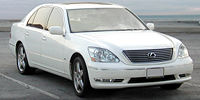
The updated LS 430 (UCF30 II) was introduced in 2004. Lexus freshened the front and rear fascias, adding redesigned adaptive projector headlamps (which swiveled in the direction of vehicle turns), LED taillights, and different wheels. The transmission received an added sixth gear. The 0-60 time was shaved to 5.9 seconds (a 0.4 sec. improvement over the UCF30 I model). A backup camera, Lexus Pre-Collision System (which used millimeter-wavelength radar to predict crashes), and related Dynamic Laser Cruise Control were new options. A power moonroof and power rear sunshade, both former options, became standard.
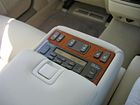
Interior updates in the UCF30 II LS 430 included the fourth generation Lexus navigation system, Bluetooth, knee airbags, and lighted rear-seat vanity mirrors.[34] With the new SmartAccess feature, the LS could detect the key fob in the owner's pocket and unlock the doors by touch. Individual key fobs could also be programmed with driver memory settings, allowing the vehicle to prepare the cabin for the use of a specific driver. New trim selections included antique walnut or golden bird's eye maple wood trim and ecru perforated leather.
The LS 430 was the most reliable luxury sedan in the J.D. Power and Associates Initial Quality Survey in every year of production (with the early and late models of this series the best performing),[53][54] and the highest recorded scorer in J.D. Power's Vehicle Dependability Survey, with few or no problems after three years of ownership.[1] In 2004 and 2005, Consumer Reports named the UCF 30 II LS 430 as the "Best Car We Ever Tested,"[55] citing independent testing and customer reviews.
Fourth generation (USF40 / USF41)
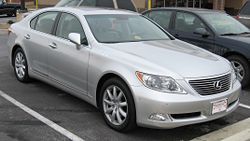 |
|
| Production | 2007–present |
|---|---|
| Layout | Front engine, rear-wheel drive / four-wheel drive |
| Engine(s) | 1UR-FSE 4.6 L V8 380 hp (280 kW) 1UR-FE Middle East version |
| Transmission(s) | 8-speed automatic |
| Wheelbase | SWB - 116.9 in (2969 mm) LWB - 121.7 in (3091 mm) |
| Length | SWB - 198 in (5029 mm) LWB - 202.8 in (5151 mm) |
| Width | 73.8 in (1875 mm) |
| Height | 58.1 in (1476 mm) Hybrid: 58.3 in (1481 mm) 57.7 in (1466 mm) (air suspension) |
| Curb weight | 4244 lb (1925 kg) (USF40) 4332 lb (1964 kg) (USF41) |
| Fuel capacity | 22.19 US gal (84 L/18 imp gal) |
| Related | Lexus LX |
USF40 / USF41 (2007)
Introduced at the 2006 North American International Auto Show, the redesigned 2007 LS is the first Lexus model offered in both standard and long wheelbase versions. The LS 460 (USF40) uses the standard 116.9 in. (2969 mm) wheelbase, while the LS 460 L (USF41) features a stretched 121.7 in. (3091 mm) wheelbase. Based on the LF-Sh concept vehicle and using an all-new platform, the LS 460 and LS 460 L feature a brand-new 4.6 L 1UR-FSE V8 producing 380 hp (283 kW) and 367 ft·lbf (498 N•m) of torque. The new LS also contains the world's first eight-speed automatic transmission.[5] The car's complex electronic and safety systems were shown in further detail at the Geneva Motor Show in February 2006, while an all-wheel drive hybrid version,[56] the LS 600h L, made its debut at the New York Auto Show in April 2006. A standard wheelbase hybrid model, the LS 600h, went on sale in Japan and Europe in mid-2007, and an all-wheel drive version of the non-hybrid LS 460 premiered at the Moscow Motor Show in 2008.[57] Lexus refers to the multiple variants of the 2007 LS design as the new LS Series.[58]
The fourth generation Lexus flagship is the first LS to receive the styling cues of Lexus' new design direction, L-finesse. The design features body forms running the length of the car, with wheel arches, arrow-shaped chrome trim, a grille set slightly below the level of the headlamps, and a smooth profile.[59] Additional details of the design include adaptive headlamps designed to look like Baccarat crystal,[60] chrome exhaust vents integrated into the rear bumper, and "L"/"S" curve shapes.
According to Lexus, standards of craftsmanship were raised to higher levels for their new flagship. A more lustrous paint finish involves wet-sanding of the entire body twice by hand,[60] a rare treatment for production vehicles. The leather on the seats and steering wheel are buffed six times longer than previously for a smoother feel.[60] Upgraded materials (such as a headliner made out of ecsaine, a suede-like material used by couturier Yves Saint-Laurent)[61] are offered for the cabin interior.
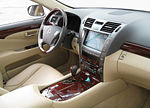
High-tech options on the new Lexus LS include a 19-speaker Mark Levinson Reference Surround Sound System, sonar-based Lexus Intuitive Park Assist, Gracenote, and a 30 GB HDD with room for 2,000 songs.[7][62] The fifth generation HDD-based Lexus navigation system features XM NavTraffic, a real-time traffic monitoring system with dynamic rerouting (in the U.S., and similar systems elsewhere). Keyless SmartAccess with push-button start, Optitron instrument panel with TFT multi-information display, auxiliary MP3 player input, and a 5-position tire pressure monitor are standard equipment.[7]
The Advanced Parking Guidance System feature can parallel-park or reverse-park the LS into a preselected space with minimal brake input at the push of a button.[63] This feature utilizes the backup camera and parking sensors.[64] Other drive-assist features include Dynamic Radar Cruise Control, which can accelerate and brake while monitoring traffic (similar to Mercedes-Benz's Distronic Plus), a Brake Hold button, which prevents creeping forward motion when the driver's foot is off the brake pedal, and the Automatic Parking Brake, which can engage the parking brake simultaneously whenever the transmission is shifted to Park.[7][63]

Comfort and convenience features range from a 16-way adjustable heated and cooled driver seat to a rear cabin with power reclining memory seats, a cool box, and five powered sunshades.[63] Certain versions of the LS can be equipped with climate control features such as first automobile ceiling air diffusers, air purifiers, air ionisers, and four-zone climate control with infrared body temperature sensors.[7][65] A special-order "Executive Class Four-Seat Package" on the LS 460 L includes a rear seat DVD entertainment system with ceiling fold-down LCD screen, fixed center console with a swivel tray table, and a passenger-side shiatsu and shoulder massaging ottoman seat.[62][63] A 24-hour concierge/emergency aid service, Lexus Link, is offered in North America, with the analogous G-Link system offered in Japan. Japanese market LS sedans also feature MiniDisc compatibility, television reception, onboard security surveillance cameras, and remote cellphone access.[66]
Safety features on the latest LS include multiple airbags, standard stability/traction control systems (with disable button),[67] anti-lock brakes, and additional emergency assist features. Newly developed advanced safety features (see below) making their world premiere on the LS 460 and LS 460 L include the Driver Monitoring System and the front and rear pre-crash capabilities of the Lexus Pre-Collision System. These systems include facial recognition, infrared night vision, and pedestrian detection faculties.
LS 460 L
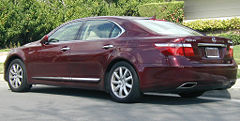
The long wheelbase LS 460 L was the debut vehicle of the LS Series at the 2006 North American International Auto Show. The LS 460 L sports an added 4.8 inches (121.9 mm) of length, affording passengers a more capacious rear compartment, and adds more luxury and performance features. Exterior-wise, the LS 460 L has a similar profile as the LS 460, with identical overhangs in both front and rear; the rear passenger doors are noticeably longer in the stretched model. Standard amenities include a power open/close trunk, heated steering wheel, backup camera, navigation system, XM NavTraffic in the U.S., Bluetooth, semi-aniline leather interior, and heated/cooled power memory rear seats.[58] The LS 460 L offers the Variable Gear Ratio Steering (VGRS) and the Adaptive Variable Air Suspension performance upgrades; the air suspension features normal, comfort, and sport modes. Compared to the standard wheelbase LS 460, the LS 460 L adds up to 250 lb (110 kg) of weight while still matching the 0-60 acceleration of its lighter stablemate,[68] listed at 5.4 seconds.[58] The "Executive Class Four-Seat Package" with massaging rear seat is an option for chauffeured customers.
The U.S. base price for the 2007 LS 460 L was $71,715.[62] However, from 2006–2007, the average price paid for a LS 460 L in the U.S. was $81,988, due largely to added options packages.[62] The price premiums for the long wheelbase model put the Lexus LS in the same price range as its long wheelbase Audi, BMW, and Jaguar rivals for the first time.[62]
Global launch
The 2007 Lexus LS went on sale in Japan on September 19, 2006. It was the first time the car was sold under the Lexus marque in Japan, and identified the next phase of Lexus' launch as a global luxury brand. The LS 460 and LS 460 L arrived at dealerships in the United States on October 20, 2006. Sales of the LS 460 began in Europe in late 2006. In early 2007, the redesigned Lexus LS reached the Middle East and other Asian countries. The LS 460 arrived in Australia in mid-2007.

The fourth generation LS received international media attention at its official launch. Among the automotive press, Automobile Magazine called the latest LS "a new benchmark for the category" of luxury flagship sedans,[69] while Edmunds.com described the standard wheelbase model (which carried a U.S. base price of $61,000)[63] as having an interior of "perfection" while "not yet" an equal to its rivals with driving dynamics and standard suspension.[70] Edmunds.com later praised the LS 460 L for its performance and air suspension.[68] Some critics such as Top Gear and Road and Track further described the new LS as directed more towards luxurious comfort and quiet versus sport, similar to previous LS models,[71][72] while others found that the new model exhibited improved performance.[69][73][74]
The Advanced Parking Guidance System, the most attention-grabbing feature of the new LS, was featured on news programs such as ABC's World News with Charles Gibson and Good Morning America in the U.S., international cable news networks, popular talk shows such as The Oprah Winfrey Show, and numerous print publications and automotive news sites. Reviewers had different reactions to the feature, with its utility eliciting multiple responses ranging from useful to impractical, depending on the parking situation and driver.[75]
At the 2007 New York International Auto Show, the LS 460 received the World Car of the Year award, selected by automotive journalists from twenty-two countries. The panel commented that the LS was “the embodiment of the Lexus brand’s 'pursuit of perfection.'"[5]
UVF45 / UVF46 (2008)
The original concept vehicle for the LS 460, the LF-Sh, featured a hybrid powertrain and all-wheel drive. Lexus subsequently debuted these technologies in production form with the launch of its hybrid LS flagship vehicles, the LS 600h and LS 600h L.
LS 600h / LS 600h L
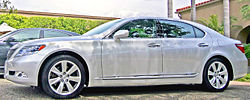
Lexus introduced the LS 600h L (UVF46), the world's first V8-powered full hybrid, at the 2006 New York Auto Show. The long wheelbase LS 600h L is equipped with Lexus Hybrid Drive, featuring a 5.0 L 2UR-FSXE V8 engine mated to a high-output electric motor with nickel-metal hydride battery packs. This system generates an output of 438 hp (327 kW), comparable to V12 sedans such as the BMW 760Li (which also produces 438 hp). The LS hybrid features all-wheel drive with a Torsen limited-slip differential, is equipped with a two-stage continuously variable transmission (CVT) along with the Adaptive Variable Air Suspension, and achieves an environmentally-friendly Super Ultra Low Emission Vehicle (SULEV) rating. The 600h L mileage, at 20 mpg city, 22 highway, and 21 combined, is slightly higher overall than the lower-powered non-hybrid 460 L's 16/24/19 mpg numbers (these are EPA 2008 model-year figures).[76] In Europe, the LS 600h has been rated at 9.5 L/100 km (24.8 mpg U.S.), the LS 460 at 11.1 L/100 km (21.2 mpg U.S.).[77] The transmission features a three-mode power switch for control of torque output between hybrid (normal), power, or snow modes; an additional EV mode allows for ultra-quiet driving under full electric power. Because of the silent nature of its hybrid design, the LS hybrid is among the quietest sedans ever built.[6] A standard wheelbase version destined for Asia and Europe, the LS 600h (UVF45), was unveiled in Japan in April 2006. Sales for both vehicles were targeted at a mid-2007 release.
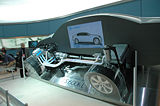
The LS 600h and LS 600h L are positioned as the halo vehicles of the Lexus LS series, and are equipped with the highest levels of technology and luxury features ever offered on the Lexus flagship.[6] In addition to BMW 760Li, the LS 600h L will compete with the range-topping Mercedes-Benz V12 S-Class models (e.g. S600), whose prices exceed $120,000. After its press debut, the LS 600h L's price was speculated to be higher than any previous Lexus,[78] and on April 6, 2007, Lexus announced that the U.S. base price for the LS 600h L would be over $104,000.[79] With a price reaching six figures, the LS 600h L elevates Lexus into the ultra-luxury stratum for the first time.[80][81]

Features specific to the LS hybrids include the first production LED headlight systems in the United States of America,[6] a leather-trimmed dash, two-tone leather, additional wood trim, and multi-zone climate control with infrared body temperature sensors. A different multi-link front suspension, expressly developed for the LS 600h/LS 600h L, is standard, while an optional Active Stabilizer Control system for the air suspension provides further stability during high-speed maneuvering. A unique black opal color option and differently-hued trunk "600h," "hybrid," and Lexus emblems further distinguish the LS hybrids. The standard SmartAccess key fob can also be substituted with a SmartAccess wallet-sized "smart card"; at just 3.35 millimeters thick, the "smart card" is the world's thinnest automobile smart key.[82]
For 2007, Lexus announced the LS 600h L "Launch Edition" for the first 100 LS hybrids sold in the U.S, sold through upscale department store Neiman Marcus.[83] By March 2007, the initial allocation of LS hybrids in the U.S. was nearly sold out, with 1,850 preorders placed months before debut.[79] In 2008, Lexus increased the trunk space in the LS hybrids by 20%, due to a redesign of the rear battery area.[84] The LS hybrid's environmental impact characteristics prompted several company executives[85] and heads of state to acquire the vehicle.[86][87][88]
As of October, 2007, Lexus sold 6,093 LS 600h's worldwide. When the LS hybrid originally went on sale in July 2007, Lexus initially targeted 7,000 total units for the year.[89]
Advanced safety systems
The fourth generation Lexus LS incorporates multiple new active and passive safety features. The comprehensive active safety feature on the Lexus LS, the Lexus Pre-Collision System (PCS), now utilizes millimeter-wavelength radar, stereo cameras, and infrared night vision projectors to prevent accidents. This system, called "Pre-Crash" internationally, includes an obstacle detection and warning system with the first automotive implementation of an image processing chip capable of identifying vehicles, pedestrians, and lane markers in real time.[91][92] The Lexus system provides audiovisual warnings, steering and brake support, and tightens the seat belts. Some radar-based versions of the Lexus system also offer rear sensing and can adjust the head restraints to reduce the risk of whiplash injuries. With this capability, PCS features the Driver Monitoring and Lane Keeping Assist systems, Emergency Steering Assist, and the frontal and rear Pre-Crash response systems:
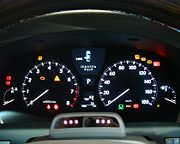
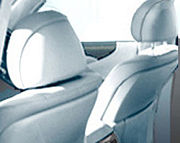
- The Driver Monitoring System uses a CCD camera placed on the steering column to track driver attentiveness by eye tracking.[93] Using infrared LED detectors, this system will respond if a collision is imminent and the driver not paying attention[94] (a warning alarm will sound followed by a brief automatic application of the braking system). This system is said to be the first of its kind.[93] In the U.S., the Driver Monitoring System debuted on the LS 600h L sedan.[6]
- The Lane Keeping Assist (not available on the LS600h due to conflict with LED headlamps) feature includes the Lane Departure Warning (LDW) and Lane Keep (LK) systems. When activated, the LDW system will issue an audiovisual warning and apply a brief corrective steering response when veering motion is detected.[95] The LK system (activated when the adaptive cruise control is engaged) will actively provide continued steering inputs to return the LS to its proper lane.[94]
- The Emergency Steering Assist system acts to minimize body roll and improve vehicle responsiveness in sudden maneuvers. This system reduces the steering gear ratio and prompts the suspension to adopt stiffer settings,[95] helping make emergency maneuvers more stable and controlled.
- The Frontal Pre-Crash system will activate a warning buzzer and red dash lights to alert the driver if a potential hazard is detected in the vehicle's path.[94] If the system detects a potential collision, the Emergency Steering Assist and brake assist systems will activate, increasing effectiveness in emergency maneuvers and stopping. If a collision is determined to be unavoidable, the seatbelt pretensioners will activate, and the brakes will automatically engage to slow the vehicle.[95]
- The Rear Pre-Crash system, the first active rear collision safety feature in an automobile,[96] utilizes trunk-mounted obstacle detection and warning systems to react in anticipation of an emergency. In addition to driver alerts, if a rear collision is deemed unavoidable, sensor-equipped Pre-Crash Intelligent Headrests in the front seats will adjust position upwards (up to 25 mm) and forwards (up to 60 mm) to cradle the head during impact,[97] reducing the risk of whiplash. In the U.S., the inclusion of the rear Pre-Crash system is pending FCC regulatory approval.[98]
On the fourth generation Lexus LS, standard active safety features also include electronically controlled braking (ECB), anti-lock brakes (ABS), and traction control (TRAC). The stability/traction control system, Vehicle Dynamics Integrated Management (VDIM), incorporates ECB, electric brake force distribution; related systems include Vehicle Stability Control, Adaptive Variable Suspension, and the Variable Gear Ratio Steering systems.[94] VDIM integrates these systems to improve vehicle responsiveness to driver input and prevent loss of control.
Passive safety features include eight to ten standard airbags (depending on model, up to eleven with upgraded rear seats),[94][99] passenger detection systems, front and rear crumple zones, three-point seatbelts with pretensioners and force limiters, and a reinforced steel body.[100] Dual-stage driver and twin-chambered front passenger airbags, full-length side curtain airbags, front knee airbags, and Thorax-Abdomen-Pelvis (TAP) airbags are also installed.[95]
LS series variants
Different models based on the standard (USF40) and long wheelbase (USF41) platforms are sold worldwide. From 2007, rear-wheel drive is offered with the 4.6 L gasoline powered V8, and all-wheel drive is featured with the 5.0 L hybrid V8. All-wheel drive was added to non-hybrid models for 2009 with the addition of front passenger memory function. Some markets receive a modified 4.6 L V8 engine without direct injection. The standard (UVF45) and long wheelbase (UVF46) hybrid models feature a two-stage planetary-gear continuously variable transmission (CVT).
| Lexus LS series | ||||||
|---|---|---|---|---|---|---|
| Model no. | Year | Drivetrain | Transmission | Engine type | Engine code | Region |
| LS 460 | 2007- | RWD/AWD | 8-speed automatic |
4.6 L petrol V8 | 1UR-FSE | U.S., Canada, Japan, Asia, Europe, Africa |
| 1UR-FE | Middle East | |||||
| LS 460 L | 1UR-FSE | U.S., Canada, Japan, Asia, Europe, Africa | ||||
| 1UR-FE | Middle East | |||||
| LS 600h | 2008- | AWD | CVT | 5.0 L hybrid V8 | 2UR-FSXE | Japan, Europe |
| LS 600h L | U.S., Canada, Japan | |||||
Special models
Pebble Beach
For the 2009 model year, the LS 600h L was produced in a 50-unit "Pebble Beach Edition" in partnership with the Pebble Beach Company, operator of the namesake golf courses and resorts. These vehicles featured Pebble Beach badging and tags, a two-tone interior, and the choice of a travel or merchandise package.[101] The special edition was first shown at the 2008 Pebble Beach Concours d'Elegance.
Neiman Marcus
Specialty department store Neiman Marcus offered 100 individually-numbered LS 600h L "Launch Edition" sedans for early 2007, available only through the Neiman Marcus catalog for InCircle members.[83] These special models came in an exclusive Truffle Mica color with Alabaster interior.[83]
Coach edition
The LS 400 UCF20 I model was produced in a 1997 "Coach edition" limited to several hundred units. These models, produced in partnership with American leather manufacturer Coach Inc.,[102] featured Coach leather seats, embroidered emblems on the exterior, armrest, and floormats, special colors and added trim, and a Coach cabin bag.[24]
Experimental models
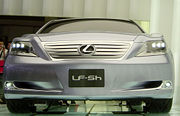
LF-Sh concept
- Further information: Lexus LF-Sh
The Lexus LF-Sh concept previewed the appearance of the fourth generation USF40/USF41 design of the Lexus LS. This concept vehicle debuted at the 2005 Tokyo Motor Show.[103] The designation refers to Lexus Future-Sedan hybrid, and the vehicle took the form of a hybrid standard wheelbase sedan model with LED headlamps.
Driving simulator
A specialized Lexus LS 460 is used in a warehouse-sized driving simulator at Toyota's Higashifuji Technical Center in Shizuoka, Japan. This vehicle is mounted inside a 4.5 x 7.0 meter high dome, and surrounded by a 360° projector screen.[104] This setup is used to simulate the audiovisual and vibration aspects of driving, which are then transmitted to a strut/track-mounted driver occupant dome containing the forward cabin of an LS 460. The occupant dome simulates vehicle motion. The driving simulator is used for testing and development of automotive safety features.[104]
Awards
- Further information: Lexus LS awards list
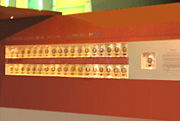
Since its debut, the Lexus LS has received numerous awards, including the following categories:
- Reliability and quality. The Lexus LS has won the J.D. Power award for "Best High-end Luxury Sedan" 13 years in a row, the most for any manufacturer, in the long-term Vehicle Dependability Study.[8][105] The Lexus LS has also been the highest-ranked luxury sedan in J.D. Power's Initial Quality Survey for 10 consecutive years.[106] In 2006, Consumer Reports awarded the Lexus LS with a repeat ranking as the most reliable vehicle in the luxury car class, and for vehicles overall.[9][107]
- Safety and security. In 2007, Auto Bild recognized the LS 460 Pre-Collision system with its 2007 Innovation Prize,[108] finding that its active safety features surpassed the rival Mercedes-Benz S-Class.[109] Kiplinger's named the 2006 LS 430 as "Best in Safety for Cars $40,000 and Over." In 2001, UK insurance centre Thatcham awarded the LS 430 with its only 5-star theft-deterrence ratings;[110] from 2002–2005, the LS 430 topped the What Car? Security Supertest with perfect 100 scores.[111]
- Advanced technology. Automotive research firm TRG found that the 2007 LS 460 offered the most advanced technological features of any vehicle available in North America.[112] The LS has won Popular Mechanics' Automotive Excellence and Popular Science's Design and Engineering Awards.[113][114] Citing its world's firsts, the official publication of the Society of Automotive Engineers (SAE) named the LS 460 as 2007's Best Engineered Vehicle,[65] and CNET.com named the 2007 Lexus LS 460 L its "Tech Car of the Year."[115]
- Best-in-class features. Edmunds.com named the LS 430's Mark Levinson premium sound system as the "Best Sound System in Cars Over $30,000" in consecutive top 10 lists in 2002–2005.[116] Car Audio and Electronics ranked the LS ahead of its competition in the areas of audio, navigation and ergonomics.[117]Ward's Auto named the LS 400's V8 engine to its 10 Best Engines awards lists from 1998–2000. In its 2002 luxury sedan comparison test, Automotive Marketing Consultants, Inc. found that the Lexus LS had the quietest cabin of any luxury car, with an idle reading of just 31.1 dB in the front seat.[2]
- Value and loyalty. Kelley Blue Book gave the Lexus LS its Best to Hold Value Award in 2001, 2002, and 2003.[118] The LS is also a repeated Intellichoice Best Overall Value awardee in the luxury class, and was R. L. Polk & Co.'s Polk Automotive Loyalty Award recipient from 2001 through 2005 for customer retention.[119]
- Luxury car. In 2007, the LS 460 was named Luxury Car of the Year at the North American International Auto Show and was selected as the Best Luxury Car at the Fleet World Honours.[120][121] In 2006, Kiplinger's named the Lexus LS as the best luxury car for the sixth time.[122] Consumer Reports named the LS as the highest-rated luxury car in 2004, 2005,[55] and 2008. In 1989 and 2004, the Lexus LS was named as the Car and Driver best luxury car.[35][123] Consumer Reports ranked the LS 460 L highest in the premium luxury category with 99pts out of 100, a full 13pts ahead of the S550.[124]
- Car of the Year. The Lexus LS has been named Wheels magazine’s Car of the Year, Canadian Car of the Year, Top Gear's Limousine of the Year, and Japan Car of the Year (won by both the original LS 400 and the fourth generation LS 460), among similar awards. In 2007, the LS 460 was named the planet's best automobile at the World Car of the Year (WCOTY)[5] and International Car of the Year (ICOTY) awards.[120]
Pop culture
- An LS 430 is driven by Hector Salazar and Wayne Palmer in season 3 of 24 and by Phillip Bauer in season 6.
- In early episodes of The Sopranos, Christopher Moltisanti drives a Lexus LS 400, which in the very first episode is used by Tony Soprano to run down a man who owes him money.
- In season 4 of Entourage, Ari Gold drives an LS 600h L, and gets stopped by police for speeding.
- The LS 600h L is featured in the video game Test Drive Unlimited.
Popularity
- 1-year Backorder. Ward's Auto and other media outlets have reported that the new Lexus LS 600h first year's (2007) allocation is already sold out and that there is a 1-year backorder.[79]
Technical specifications
| Lexus LS model year | ||||||
|---|---|---|---|---|---|---|
| 1990–1994 | 1995–1997 | 1998–2000 | 2001–2006 | 2007- | 2008- | |
| Engine | 4.0 L V8 | 4.0 L V8 | 4.0 L V8 | 4.3 L V8 | 4.6 L V8 | 5.0 L V8 hybrid |
| Gears | 4 | 4 | 5 | 5–6 | 8 | CVT |
| Power | 191 kW (250 hp) | 194 kW (260 hp) | 214 kW (290 hp) | 214 kW (290 hp) | 283 kW (380 hp) | 327 kW (438 hp) |
| Torque | 353 Nm (260 ft·lbf) @4400 rpm | 366 Nm (270 ft·lbf) @4500 rpm | 407 Nm (300 ft·lbf) @4000 rpm | 434 Nm (320 ft·lbf) @3400 rpm | 498 Nm (367 ft·lbf) @4100 rpm | N/A |
References
Notes
- ↑ 1.0 1.1 "Toyota, Lexus lead way in J.D. Power dependability study" (HTML). ReliablePlant (2007). Retrieved on 2007-04-08.
- ↑ 2.0 2.1 "AMCI Declares Lexus LS 430 `Finest Luxury Sedan in America`" (HTML). Autochannel/AMCI (2002-02-11). Retrieved on 2007-04-08.
- ↑ 3.0 3.1 Press, Jim (2006-01-09). "Lexus News Conference - 2006 North American International Auto Show" (HTML). Lexus. Retrieved on 2007-04-08.
- ↑ "The Lexus LS is the best-selling premium luxury sedan in America". St. Louis Dispatch (2007-03-11). Retrieved on 2007-04-10.
- ↑ 5.0 5.1 5.2 5.3 5.4 "Lexus LS 460 - 2007 World Car of the Year" (HTML). World Car of the Year (2007-04-05). Retrieved on 2007-04-08.
- ↑ 6.0 6.1 6.2 6.3 6.4 Peterson, Thane. "Lexus' New Luxury V8 Hybrid" (HTML). BusinessWeek. Retrieved on 2006-12-01.
- ↑ 7.0 7.1 7.2 7.3 7.4 "Lexus LS USA Specifications" (2007). Retrieved on 2007-04-09.
- ↑ 8.0 8.1 "Lexus leads nameplate rankings for 12 years in a row" (HTML). Stoney Creek News (2006-09-08). Retrieved on 2007-04-08.
- ↑ 9.0 9.1 "The Lexus LS tops Consumer Reports survey, year in and year out" (HTML). Associated Press (2007-04-08). Retrieved on 2007-04-10.
- ↑ Dawson 2004, p. xxi
- ↑ Mahler 2004, p. 31
- ↑ Dawson 2004, p. 45-46
- ↑ Brown, David (2001-06-19). "David Brown Motoring - Lexus LS 430" (HTML). ABC New South Wales. Retrieved on 2007-04-08.
- ↑ Dawson 2004, p. xxi-xxiii, 70-71
- ↑ Dawson 2004, p. 24, 70
- ↑ Dawson 2004, p. 50-51
- ↑ Mahler 2004, p. 46-48
- ↑ Dawson 2004, p. 89
- ↑ Mahler 2004, p. 78
- ↑ Dawson 2004, p. 52
- ↑ Dawson 2004, p. 24
- ↑ Dawson 2004, p. xvii, 64
- ↑ "Toyota Digital Catalog - Celsior (トヨタ デジタルカタログ-セルシオ)" (HTML). SegaGaGa (2007-08-17). Retrieved on 2008-10-20.
- ↑ 24.0 24.1 24.2 24.3 24.4 "Lexus Knowledge Base" (PDF). Lexus (2007). Retrieved on 2007-04-08.
- ↑ Mahler 2004, p. 112
- ↑ Dawson 2004, p. 76
- ↑ Tierney, Christine (2004-02-22). "Robot-filled Tahara sets standard for Toyota, world" (HTML). Detroit News. Retrieved on 2007-04-08.
- ↑ Woodcock, Glen. "Living Large in Lexus" (HTML). Calgary Sun. Retrieved on 2007-04-08.
- ↑ 29.0 29.1 29.2 "Lexus (in the lap of latent luxury)". AutomoBear.com (2004-09-23). Retrieved on 2007-04-09.
- ↑ Yap, Chips (2006-12-12). "The creation of Lexus". Malaysian Motor Trader. Retrieved on 2008-08-21.
- ↑ Dawson 2004, p. 71
- ↑ Davis, David E. Comparison: Audi V8, BMW 535i, Infiniti Q45, Lexus LS400, Mercedes-Benz 300E. Automobile Magazine, November 1989, p.64-72.
- ↑ [1]
- ↑ 34.0 34.1 34.2 34.3 34.4 34.5 "Lexus LS 400, LS 430 and LS 460 Generations: Setting the Standard in the Most Comfortable Way Possible" (HTML). Edmunds.com (2003-03-13). Retrieved on 2007-04-08.
- ↑ 35.0 35.1 Bedard, Patrick. Comparison Test: Showdown Car & Driver, Vol. 35, Issue 6 December, 1989
- ↑ Dawson 2004, p. 70, 76
- ↑ Dawson 2004, p. 70-73
- ↑ [2]
- ↑ Detroit, S.C. Gwynne (1990-09-17). "Lexus: New Kid on the Block". Time Magazine. Retrieved on 2007-04-29.
- ↑ Dawson 2004, p. 147-148
- ↑ Dawson 2004, p. 137
- ↑ 24 Most Important Vehicles of the 20th Century. Automobile, September 1996
- ↑ 43.0 43.1 43.2 43.3 43.4 43.5 43.6 "Lexls.com: Lexus LS Generations - Evolution of the LS Series" (HTML). LexLS.com. Retrieved on 2007-04-08.
- ↑ Dawson 2004, p. 145, 147
- ↑ 45.0 45.1 45.2 45.3 45.4 45.5 "Improving on near perfection" (HTML). New Car Test Drive.com (2005). Retrieved on 2006-12-01.
- ↑ 46.0 46.1 46.2 46.3 Dawson 2004, p. 149-150
- ↑ Binstock, Michael (2000-11-16). "Lexus LS 430 - The best gets better" (HTML). The Acorn. Retrieved on 2007-04-08.
- ↑ Vasilash, Gary (2005-04). "Driven Article - 2005 Lexus LS 430" (HTML). Automotive Design and Production. Retrieved on 2007-04-08.
- ↑ 49.0 49.1 "Comprehensive Lexus LS 430 reviews at Carsdirect.com". Carsdirect.com (2007). Retrieved on 2007-04-09.
- ↑ 50.0 50.1 Kim, Liz (2001-06-04). "Resplendency Full Test: 2001 Lexus LS 430". Edmunds.com. Retrieved on 2007-04-09.
- ↑ Stennick, Kelly (2004-01-21). "Lexus LS 430 - Lap of Luxury" (HTML). Edmunds.com. Retrieved on 2007-04-09.
- ↑ Bedard, Patrick (2003-12). "$70,000 Luxury Sedans - Comparison Tests, Car & Driver, December 2003" (HTML). Car & Driver. Retrieved on 2007-04-08.
- ↑ Jensen, Cheryl (2006-8-16). "For long-term car dependability, check the initial quality" (HTML). The New York Times. Retrieved on 2007-04-08.
- ↑ "LS 430 ratings at Edmunds" (HTML). Edmunds.com (2004). Retrieved on 2007-04-08.
- ↑ 55.0 55.1 Peterson, Thane (2005-9-16). "Lexus LS 430: More Luxury for Less" (HTML). BusinessWeek. Retrieved on 2007-04-08.
- ↑ Lyons, Peter (2006-08-21). "AutoWeek 2007 Lexus LS 460" (HTML). AutoWeek. Retrieved on 2007-04-08.
- ↑ Parrott, Victoria (2008-08-19). "Lexus LS460 gets 4x4". Autocar. Retrieved on 2008-08-21.
- ↑ 58.0 58.1 58.2 "Lexus.com - LS Series" (HTML). Lexus (2007). Retrieved on 2007-04-08.
- ↑ Newbury, Stephen. The Car Design Yearbook 5: The Definitive Annual Guide to All New Concept And Production Cars Worldwide. Merrell, 2006, p. 162-63. ISBN 1858943191.
- ↑ 60.0 60.1 60.2 Vasilash, Gary (2006-08-30). "Lexus Comes Into Its Own" (HTML). Automotive Design and Production. Retrieved on 2007-04-08.
- ↑ "Lexus Reveals Details of New 2007 LS 460" (HTML). Global Auto Systems (2006-08-15). Retrieved on 2007-04-08.
- ↑ 62.0 62.1 62.2 62.3 62.4 Peterson, Thane (2007-02-14). "BusinessWeek - Lexus LS 460: More Luxury for Less" (HTML). BusinessWeek. Retrieved on 2007-04-08.
- ↑ 63.0 63.1 63.2 63.3 63.4 Ofria, Charles (2006-08-30). "Familycar 2007 Lexus LS 460 Preview" (HTML). FamilyCar.com. Retrieved on 2007-04-08.
- ↑ Wiese, Dan (2007-03-11). "For well-heeled drivers who face parallel panic, Lexus LS 460 is the parking ticket". St. Louis Post-Dispatch. Retrieved on 2008-05-28.
- ↑ 65.0 65.1 ":Automotive Engineering International Magazine Names Lexus LS 460 As 2007 Best Engineered Vehicle". SAE International (2007-04-10). Retrieved on 2007-05-06.
- ↑ "Lexus LS Japan Specifications" (in Japanese) (2007). Retrieved on 2007-04-09.
- ↑ Neff, John (2006-08-28). "World's First Lexus LS 460 Gets Loose" (HTML). Autoblog. Retrieved on 2007-04-08.
- ↑ 68.0 68.1 Riches, Erin (2007-01-31). "LS 460 L Follow-Up Test, the Sleeper Phenomenon". Edmunds.com. Retrieved on 2007-03-05.
- ↑ 69.0 69.1 Cumberford, Robert (2006). "LS 460 exceeds and provides a new benchmark for S-Class and 7-Series" (HTML). Automobile. Retrieved on 2007-04-08.
- ↑ Brown, Greg (2006-10-19). "LS, not yet an equal to S-Class and 7-Series?". Edmunds.com. Retrieved on 2006-10-21.
- ↑ Clarkson, Jeremy (2007-02-11). "Lexus LS 460 SE-L When the beeping stops, you may go". The Sunday Times. Retrieved on 2007-04-09.
- ↑ Rusz, John (2006-12). "Road & Track 2007 Lexus LS 460 review". Road & Track. Retrieved on 2007-04-09.
- ↑ Lienert, Anita; Lienert, Paul (2006-11). "Lexus flagship defines first class". Detroit News. Retrieved on 2006-11-15.
- ↑ McCraw, Tim (2006-09). "The Silent Rocket". Winding Road. Retrieved on 2006-12-01.
- ↑ "Motorweek Lexus LS 460 test drive" (FLV). Motorweek (2007). Retrieved on 2007-04-09.
- ↑ "U.S. Government fuel economy ratings". Retrieved on 2007-11-27.
- ↑ Combined cycle; Lexus.it LS 600h data and Automobil Revue, catalogue edition 2007, p. 296.
- ↑ Welch, David (2006-01-09). "A Lexus Aimed at Mercedes' S-Class" (HTML). BusinessWeek. Retrieved on 2007-04-08.
- ↑ 79.0 79.1 79.2 Hill, Brandon (2007-04-10). "Lexus LS 600h L to retail for $104,750 USD". Dailytech. Retrieved on 2007-04-10.
- ↑ Maynard, Micheline (2006-04-17). "Lexus enters ultra-luxury arena". International Herald Tribune. Retrieved on 2007-11-21.
- ↑ Ofria, Charles (2007). "2008 Lexus LS600h L Road Test Review, ultra-luxury group". FamilyCar. Retrieved on 2007-11-21.
- ↑ "DENSO Develops New Advanced Products for Lexus LS460" (HTML). Denso Corp. (2006-09-25). Retrieved on 2007-04-08.
- ↑ 83.0 83.1 83.2 "Lexus Rolls Out LS 600h L Launch Edition Via Neiman Marcus". Edmunds.com (2007-01-04). Retrieved on 2008-05-28.
- ↑ Nagpal, Sahil (2008-11-05). "More luggage space for Lexus hybrid models". TopNews.in. Retrieved on 2008-11-15.
- ↑ Madslien, Jorn (2008-03-16). "Lexus hybrid woos Sainsbury's chief". BBC News. Retrieved on 2008-05-28.
- ↑ "Le Prince Albert roule en LS 600" (in French). Motorlegend.com (2007-06-07). Retrieved on 2007-09-28.
- ↑ "Engin peningasóun" (in Icelandic). Visir.is (2007-07-07). Retrieved on 2008-05-28.
- ↑ Johansen, Magne (2008-02-05). "King gets fancy new car". Aftenposten.no. Retrieved on 2008-05-28.
- ↑ Lexus sells 6,093 LS 600h Hybrids in 5 months
- ↑ http://www.lexus.com/models/LSh/pebble_beach_edition/index.html
- ↑ "NEC Electronics launches image chips for cars" (HTML). Reuters (2006-08-25). Retrieved on 2007-04-08.
- ↑ "IMAPCAR® Image Processor Adopted in Lexus LS460 Pre-crash Safety System" (HTML). Technology News (2006-08-28). Retrieved on 2007-04-08.
- ↑ 93.0 93.1 "LS460 achieves a world-first in preventative safety" (HTML). NewCarNet.co.uk (2006-08-30). Retrieved on 2007-04-08.
- ↑ 94.0 94.1 94.2 94.3 94.4 "Auto Bild Safety Comparison LS460 vs. S550" (HTML) (in German). Auto Bild (2006-12-05). Retrieved on 2007-04-09.
- ↑ 95.0 95.1 95.2 95.3 "Lexus LS 460 safety features" (HTML). Lexus.co.uk (2006). Retrieved on 2007-04-08.
- ↑ Kageyama, Yuri (2007-02-11). "Rear collision warnings part of Toyota's safety features" (HTML). Associated Press. Retrieved on 2007-04-08.
- ↑ "Lexus Introduces World's First Driver Monitoring System". BusinessWeek/Gizmag (2007-09-07). Retrieved on 2008-05-28.
- ↑ Tayman, John (2006-03-15). "Business 2.0 What's cool: The self-parking Lexus LS 460L". CNNMoney.com. Retrieved on 2007-02-01.
- ↑ "2007 Lexus LS 460 First Drive" (HTML). AutoSite (2006). Retrieved on 2007-04-08.
- ↑ "Lexus LS460 into Saudi" (HTML). AMEInfo.com (2007-02-05). Retrieved on 2007-04-08.
- ↑ "2009 Lexus LS 600h L Pebble Beach Edition joins sixth SC". Motor Trend (2008-08-17). Retrieved on 2008-06-21.
- ↑ Rechtin, Mark. (1995-03-15). Once Again, Lexus Links with Coach Leather. Automotive News, March 15, 1999, p.24
- ↑ "Lexus LF-Sh Concept". Automobile Magazine (2005). Retrieved on 2008-05-28.
- ↑ 104.0 104.1 Kageyama, Yuri (2007-11-26). "'World's biggest Playstation' tests safety systems". Motoring.co.za. Retrieved on 2008-05-28.
- ↑ "J.D. Power and Associates 2007 Vehicle Dependability Study" (HTML). J.D. Power and Associates (2006-08-09). Retrieved on 2007-08-09.
- ↑ "J.D. Power and Associates 2004 Initial Quality Study" (HTML). J.D. Power (2004-04-08). Retrieved on 2007-04-08.
- ↑ Palmer, Beth (2006-02-11). "Finding and Keeping a Reliable Luxury Car" (HTML). Cars.com. Retrieved on 2007-04-08.
- ↑ ""Auto 1" Awards, Auto Bild Group" (HTML). Auto Bild (2007-03-07). Retrieved on 2007-04-08.
- ↑ "Auto Bild Safety Comparison LS460 vs. S550" (HTML) (in German). Auto Bild (2006-12-05). Retrieved on 2007-04-09.
- ↑ "5-star elite of car security" (HTML). Norwich Union Risk Services (2004-02-14). Retrieved on 2007-04-09.
- ↑ "What Car? Security Supertest 2005". What Car? (2004-12). Retrieved on 2007-04-29.
- ↑ Marchetti, Nino (2006-05-16). "TRG Proclaims Lexus LS-460 Most Techie Car" (HTML). Digital Trends News. Retrieved on 2007-04-08.
- ↑ "PM Automotive Excellence Awards 2007" (HTML). Popular Mechanics (2006-10). Retrieved on 2007-04-08.
- ↑ "Popular Mechanics Announces Winners of Design & Engineering Awards 2001" (HTML). Autochannel/Popular Mechanics (2000-11-01). Retrieved on 2007-04-08.
- ↑ "2006 CNET Car Tech Awards" (HTML). CNET (2007). Retrieved on 2007-04-08.
- ↑ DiPietro, John (2007-04-08). "Edmunds Top 10 Sound Systems in Cars Over $30,000" (HTML). Edmunds.com. Retrieved on 2007-04-08.
- ↑ "Car Audio and Electronics" (HTML). Retrieved on 2007-11-19.
- ↑ "CARFAX - Kelley Blue Book-Models to Best Hold Its Value" (HTML). Carfax (2001). Retrieved on 2007-04-08.
- ↑ "Polk Automotive Loyalty Award Winners" (HTML). R.L. Polk & Co.. Retrieved on 2007-04-08.
- ↑ 120.0 120.1 Hindes, Martha (2007-01-06). "2007 ICOTY Car of the Year" (HTML). Road & Travel. Retrieved on 2007-04-08.
- ↑ "Lexus LS wins Best Luxury Car in Fleet World Honours". Easier Motoring UK (2007-05-18). Retrieved on 2007-05-18.
- ↑ "ConsumerSearch Luxury Car Ratings & Reviews". ConsumerSearch (2006). Retrieved on 2007-05-15.
- ↑ Bedard, Patrick (2003-12). "$70,000 Luxury Sedans - Comparison Tests, Car & Driver, December 2003" (HTML). Car & Driver. Retrieved on 2007-04-08.
- ↑ "Consumer Reports Ultra-Lux Face-off, October 2007" (HTML). Consumer Reports. Retrieved on 2007-10-01.
Bibliography
- Dawson, Chester. Lexus: The Relentless Pursuit. 2004: Jon Wiley & Sons, NJ. ISBN 0-470821-10-8.
- Long, Brian. Lexus: The Challenge to Create the Finest Automobile. 2001: Veloce Publishing, Cardiff. ISBN 1-901295-81-8.
- Mahler, Jonathan. The Lexus Story: The Behind the Scenes Story of the #1 Automotive Luxury Brand in America. 2004: DK Melcher Media, NY. ISBN 0-971793-57-3.
See also
- Lexus, history of
- Lexus Hybrid Drive
External links
- All New LS.com launch site
- Lexus LS official U.S. site
- Lexus LS Showcase Europe launch site
- Lexus LS 460/600h official Europe site
- Lexus.jp/models/ls official Japan site
- LS460.ca official Canada site
- 2008 Lexus LS hybrid official U.S. hybrid site
- Lexus LS at the Open Directory Project - additional links
| Lexus – a division of Toyota Motor Corp. – road vehicle timeline | ||||||||||||||||||||
|---|---|---|---|---|---|---|---|---|---|---|---|---|---|---|---|---|---|---|---|---|
| Type | 1990s | 2000s | ||||||||||||||||||
| 0 | 1 | 2 | 3 | 4 | 5 | 6 | 7 | 8 | 9 | 0 | 1 | 2 | 3 | 4 | 5 | 6 | 7 | 8 | 9 | |
| Compact | IS | IS | ||||||||||||||||||
| IS F | ||||||||||||||||||||
| Mid-size | ES | ES | ES | ES | ES | |||||||||||||||
| GS | GS | GS | ||||||||||||||||||
| GS Hybrid | ||||||||||||||||||||
| Full-size | LS | LS | LS | LS | ||||||||||||||||
| LS Hybrid | ||||||||||||||||||||
| Crossover | RX | RX | ||||||||||||||||||
| RX Hybrid | ||||||||||||||||||||
| SUV | GX | |||||||||||||||||||
| LX | LX | LX | ||||||||||||||||||
| Coupe | SC | SC | ||||||||||||||||||